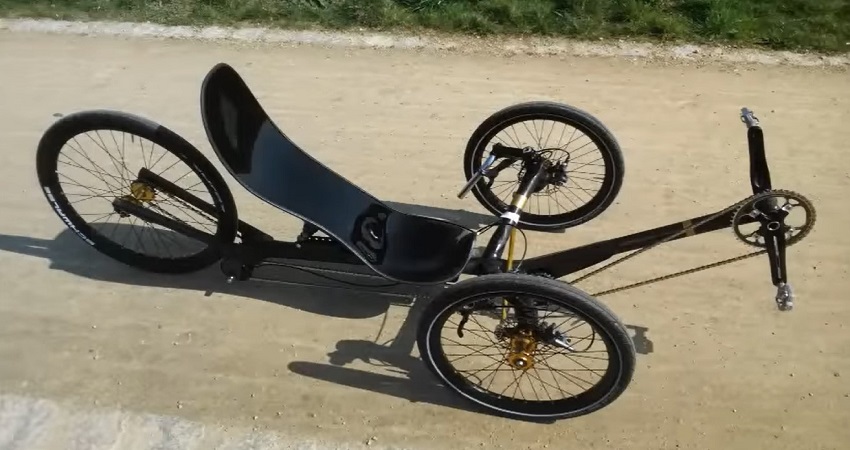A bike is a traditional upright bicycle, while a recumbent bike has a reclined seating position. The main difference between the two is the position of the rider – on a bike, the rider sits upright, while on a recumbent bike, the rider is in a reclined position.
Bikes are more commonly used and have a longer history, while recumbent bikes are known for their ergonomic design and comfort. Bicycles, also known as bikes, have been around for centuries and are a common mode of transportation and exercise.
They have an upright seating position, with the rider sitting on a saddle and leaning forward to hold the handlebars. The traditional design of a bike places the rider’s feet below the torso, and pedaling is done with a circular motion. On the other hand, recumbent bikes have a different and more ergonomic design. They feature a seat with a backrest, allowing the rider to recline comfortably while pedaling.
The pedals are positioned in front of the rider, and the feet are at about the same level as the rider’s waist. This unique setup provides a more relaxed and comfortable riding experience, reducing strain on the back, neck, and wrists. So, while both bikes and recumbent bikes serve similar purposes, their seating positions and designs differ significantly.
Design
When it comes to the design of bikes and recumbent bikes, there are some key differences that set them apart. Let’s take a closer look at the design of both types of bikes.
Bike Design
Bikes, also known as upright bikes, have a traditional design that most people are familiar with. They feature a straight frame, two wheels aligned with each other, and the rider sits in an upright position. The design of a bike allows for a more aerodynamic riding stance, with the upper body leaning forward and hands gripping the handlebars. The saddle is positioned higher, making the rider’s legs be engaged in pedaling.
The design of a bike is simple yet effective, allowing for good maneuverability and control. Since the rider is in an upright position and pedaling in a more natural motion, it is easier to balance and maintain stability. The compact design of bikes also makes them ideal for navigating narrow spaces and weaving through traffic.
Recumbent Bike Design
On the other hand, recumbent bikes have a more unconventional design. These bikes feature a reclined seating position, with the rider’s legs positioned in front of them rather than underneath. The seat is positioned low to the ground, and the rider’s back is supported by the seatback. The design of a recumbent bike allows for a more relaxed and comfortable riding experience.
Recumbent bikes come in various configurations, including two wheels aligned with each other or a tricycle design with two wheels at the front and one at the back. The handlebars are typically located at the sides of the rider’s seat, allowing for a more natural resting position for the arms. The design of a recumbent bike also redistributes the rider’s weight more evenly, reducing strain on the back, neck, and shoulders.
Comparing The Design
| Bike Design | Recumbent Bike Design |
|---|---|
| Bike features a straight frame and an upright riding position. | Recumbent bike has a reclined seating position and a lower seat. |
| Rider’s legs are positioned underneath the body. | Rider’s legs are positioned in front of the body. |
| Handlebars are positioned in front of the rider’s body. | Handlebars are positioned at the sides of the rider’s seat. |
| Compact design for maneuverability and traffic navigation. | Comfortable design with weight distribution support. |
In conclusion, the design of a bike offers an upright riding position with good maneuverability, while the design of a recumbent bike provides a more comfortable and supported reclined seating position. Both types of bikes have their own advantages and suitability depending on the rider’s preference and intended use.
Riding Position
The difference between a bike and a recumbent bike lies in the riding position. While a regular bike requires an upright stance, a recumbent bike allows the rider to recline and pedal in a more relaxed and comfortable position.
Bike Riding Position
When it comes to the riding position, traditional bikes and recumbent bikes have significant differences. On a regular bike, such as a road bike or a mountain bike, the rider sits upright with the body positioned directly above the pedals. This position allows for a more forward-leaning posture, keeping the rider engaged and ready to tackle any terrain.
Recumbent Bike Riding Position
In contrast, recumbent bikes offer a completely different riding position. With a recumbent bike, the rider sits in a reclined or laid-back position, similar to sitting in a chair. The body is supported by a comfortable seat that is positioned lower to the ground. This design allows the rider to have a more relaxed and comfortable ride.
Performance
When it comes to comparing the performance of a traditional bike and a recumbent bike, there are a few key factors to consider. Both types of bikes have their own unique advantages and disadvantages that can affect your overall riding experience.
Bike Performance
Traditional bikes, also known as upright bikes, have been around for centuries and have stood the test of time. They are known for their agility and speed, making them a popular choice for cycling enthusiasts and professional athletes.
Bikes offer a more upright riding position, which allows for better control and maneuverability. This makes them ideal for navigating through tight spaces, weaving through traffic, or tackling challenging terrains such as steep hills or rough trails.
Their design allows for quick acceleration and deceleration, making it easier to maintain a fast pace or switch gears swiftly. Additionally, the narrow and streamlined frame of a bike reduces wind resistance, enabling riders to achieve higher speeds.
However, the performance of a bike is heavily reliant on the rider’s physical fitness and ability. The traditional seating position requires riders to engage their core muscles and maintain a stable posture throughout their ride.
Recumbent Bike Performance
Recumbent bikes, on the other hand, offer a different riding experience with their laid-back and reclined seating position. This unique design provides a comfortable and ergonomic riding position that reduces strain on the rider’s back, neck, and wrists.
The recumbent bike’s lower center of gravity offers improved stability and balance, especially when navigating turns or maneuvering at high speeds. This makes recumbent bikes a popular choice for individuals with mobility issues or those recovering from injuries.
The seated position also allows for better leg extension, promoting improved blood flow and reducing the risk of muscle fatigue or cramping. Recumbent bikes offer a different muscle engagement compared to traditional bikes, focusing more on the rider’s quadriceps and hamstrings.
Additionally, recumbent bikes often come with wider and more comfortable seats, making them ideal for longer rides or anyone looking for a leisurely cycling experience.
Comparing The Performance:
| Bike | Recumbent Bike | |
|---|---|---|
| Maneuverability | Better control and agility | Improved stability and balance |
| Speed | Faster acceleration and higher speeds | Reduced wind resistance and comfortable riding position |
| Muscle Engagement | Core muscles, overall body engagement | Quadriceps and hamstrings |
In conclusion, when it comes to performance, bikes offer agility, speed, and maneuverability, while recumbent bikes prioritize comfort, stability, and reduced strain on the rider’s body. Both types of bikes are suited for different purposes and preferences, so it ultimately depends on your specific needs and riding style.
Comfort And Ergonomics
When it comes to choosing between a traditional bike and a recumbent bike, one important factor to consider is comfort and ergonomics. The level of comfort and support provided by the bike can greatly affect your overall riding experience. In this section, we will explore the differences in comfort and ergonomics between bikes and recumbent bikes.
Bike Comfort And Ergonomics
Traditional bikes are designed with an upright riding position, which can sometimes cause discomfort, especially during long rides. The forward-leaning position may put strain on your wrists, neck, and back, causing discomfort or even pain.
Additionally, the narrow and hard bicycle seats might lead to pressure points and discomfort in the buttocks area. This can become a significant issue during extended periods of riding.
The positioning of the pedals on a traditional bike can also impact comfort. Many cyclists experience numbness or tingling in their feet due to the constant pressure on the balls of the feet, which can be uncomfortable and lead to decreased performance.
Recumbent Bike Comfort And Ergonomics
In contrast, recumbent bikes offer a unique and more comfortable riding experience. Recumbent bikes feature a reclined seating position, which provides excellent support for your back and reduces strain on your neck and wrists. This ergonomically designed position encourages a more relaxed and enjoyable ride.
Another advantage of recumbent bikes is the larger and more cushioned seat. These seats are typically wider and more comfortable than those found on traditional bikes, eliminating discomfort or pain associated with pressure points.
The pedal placement on a recumbent bike differs from a traditional bike as well. Recumbent bikes have pedals positioned in front of the rider rather than below, reducing the pressure on your feet and minimizing the chances of numbness or tingling.
In conclusion, when it comes to comfort and ergonomics, recumbent bikes clearly have the upper hand. Their reclined seating position, comfortable seats, and pedal placement provide better support and reduce strain on various parts of the body, resulting in a more enjoyable and pain-free ride.
Frequently Asked Questions For What Is The Difference Between Bike And Recumbent Bike?
What Is A Recumbent Bike?
A recumbent bike is a type of exercise bike that is designed with a reclined seating position. It offers a low-impact workout and is ideal for individuals with back or joint issues. The seat is positioned lower and the pedals are positioned in front of the body, providing a comfortable and ergonomic riding experience.
How Is A Recumbent Bike Different From A Regular Bike?
Unlike a regular bike, a recumbent bike offers a more relaxed and comfortable riding position. The seats are larger and more cushioned, providing better support for the back and buttocks. The reclined position reduces strain on the wrists, neck, and shoulders.
Additionally, recumbent bikes are often equipped with features such as backrests, armrests, and adjustable resistance levels.
Is Riding A Recumbent Bike Better Than A Regular Bike?
The choice between a recumbent bike and a regular bike depends on personal preference and fitness goals. Recumbent bikes are ideal for individuals seeking a low-impact workout that puts less stress on the joints. Regular bikes, on the other hand, provide a more intense cardio workout and engage more muscles.
It’s important to choose the type of bike that aligns with your specific needs and preferences.
Conclusion
To sum it up, the key difference between a bike and a recumbent bike lies in their design and riding positions. While a traditional bike offers a more upright posture, a recumbent bike allows for a reclined and supported position.
Each option caters to different preferences and comfort levels. Ultimately, whether you choose a bike or a recumbent bike, both will offer a great way to stay fit and enjoy the outdoors.



